Acute Fatty Liver of Pregnancy
Acute fatty liver of pregnancy (AFLP) is a rare but potentially fatal condition characterized by hepatic failure.
Introduction
Acute fatty liver of pregnancy (AFLP) is a rare but potentially fatal condition characterized by hepatic failure. Typically, it occurs in the third trimester of pregnancy. Because of differing study populations, the reported incidence varies from 1 in 7000 to 1 in 20,000 pregnancies.1-4 The seriousness of this disorder is demonstrated by recent data from the U.S. Acute Liver Failure Study Group, which show that AFLP is the most common cause of acute liver failure during pregnancy—more common than drug-induced causes and hepatitis.5
Table 3. Key Take-Home Points for the Management of AFLP
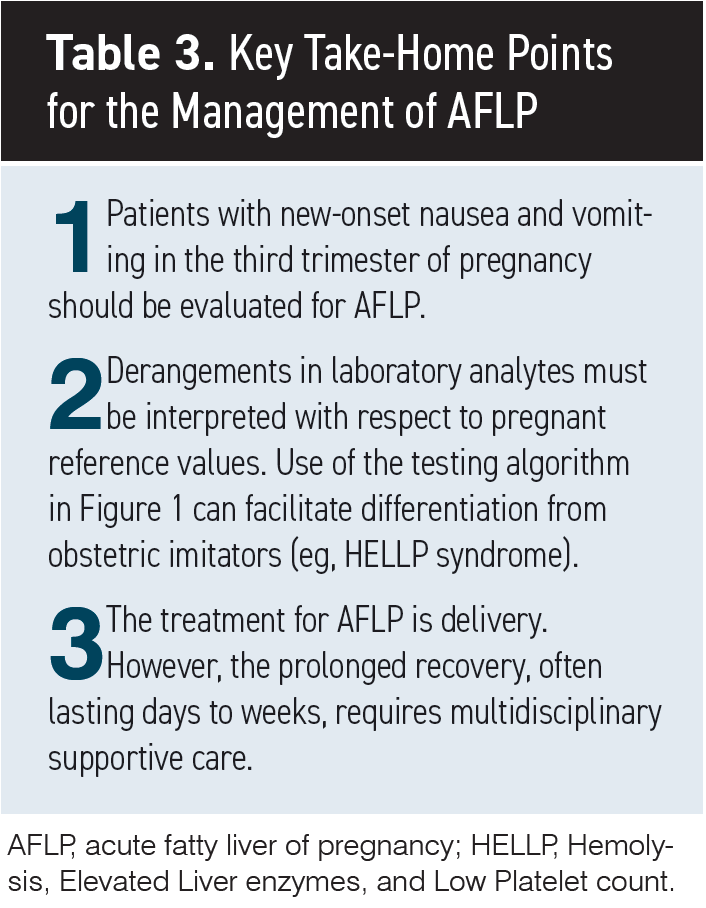
Although AFLP shares some similar clinical and laboratory features with other obstetric medical complications—such as Hemolysis, Elevated Liver enzymes, and Low Platelet count syndrome (HELLP)—specific features can enable diagnosis. Management of this serious condition requires prompt recognition with close clinical surveillance following delivery. In this article, we will highlight these clinical management considerations and provide recommendations to facilitate care in women with AFLP.
Pathogenesis
The contemporary understanding of AFLP was established with the discovery of Reye syndrome in children during the 1960s, wherein deficiencies in mitochondrial enzymes were found to be responsible for fatty acid oxidation derangements.6 It is now understood that autosomal recessive mutations in genes that encode enzymes for the fatty acid metabolism pathway cause both the clinical features as well as histological microvesicular fatty hepatocyte infiltration seen in women with AFLP.7
During normal pregnancy, the fetal-placental unit metabolizes free fatty acids for fetal growth and development. Placental enzymes break down triglycerides into free fatty acids, which are then transferred to the fetus. When defects exist in the fatty acid oxidation pathway of the fetal-placental unit, the products—intermediate fatty acid metabolites—accumulate and enter the maternal circulation.8 These intermediate metabolites and associated reactive oxygen species are taken up by the maternal liver to cause microvesicular fatty infiltration, activate inflammatory processes, and cause cellular hepatic necrosis.9
The mechanism leading to the accumulation of fatty acids and metabolites in the maternal compartment involves 2 processes. First, the fetal-placental unit shares either a homozygous or compound heterozygous mutation resulting in an enzyme defect. Second, a heterozygous mother has a decreased ability to accomplish fatty acid oxidation in late pregnancy, leading to an inability to effectively clear the accumulating fatty acid metabolites that have been transferred from the deficient fetal-placental unit.7-9
Risk Factors
The most prominent risk factors associated with AFLP include multifetal gestations, male fetus, and the aforementioned fetal fatty acid oxidation disorders.3,4,10 Although the majority of cases manifest in the third trimester, reported cases have occurred in the second trimester.11 Other risk factors include obesity, underlying metabolic disorders such as diabetes mellitus, and hepatic disorders such as intrahepatic cholestasis of pregnancy.1,4,12 Although there is a well-known association with preeclampsia, the direct cause and effect to AFLP is unclear. Because of the rarity of AFLP, clinical vigilance for associated symptomatology in all patients is paramount.
Clinical Presentation and Evaluation
The manifestations of AFLP range from minimal clinical findings and laboratory derangements to overt liver failure with hepatic encephalopathy.
Table 1. Symptoms of Acute Fatty Liver of Pregnancy
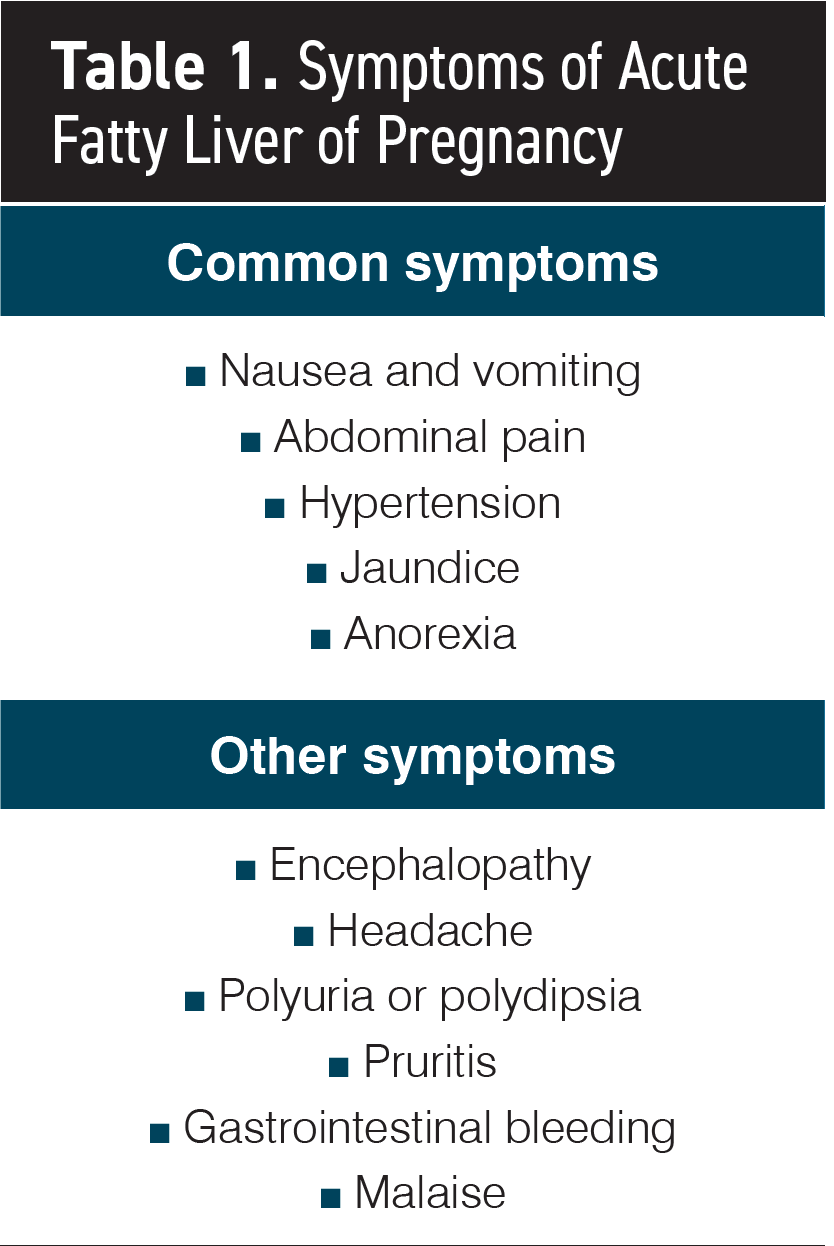
Common symptoms are listed in Table 1 and are often encountered in other obstetric “imitators,” such as HELLP syndrome, acetaminophen toxicity, and exacerbation of systemic lupus erythematosus.13,14
One of these clinical features—new-onset nausea and vomiting in the third trimester—is often associated with AFLP and merits further evaluation. The testing algorithm in Figure 1 can be used to facilitate assessment in women presenting with suspected AFLP. If clinical concern for AFLP remains high after initial laboratory evaluation, further confirmatory tests, also in Figure 1, can be obtained. These tests are readily available at most hospitals and focus on identifying hepatic and hematologic dysfunction, which are the hallmarks of AFLP.
Figure 1. Testing Protocol for the Evaluation of AFLP (Acute Fatty Liver of Pregnancy (AFLP)3,4,10
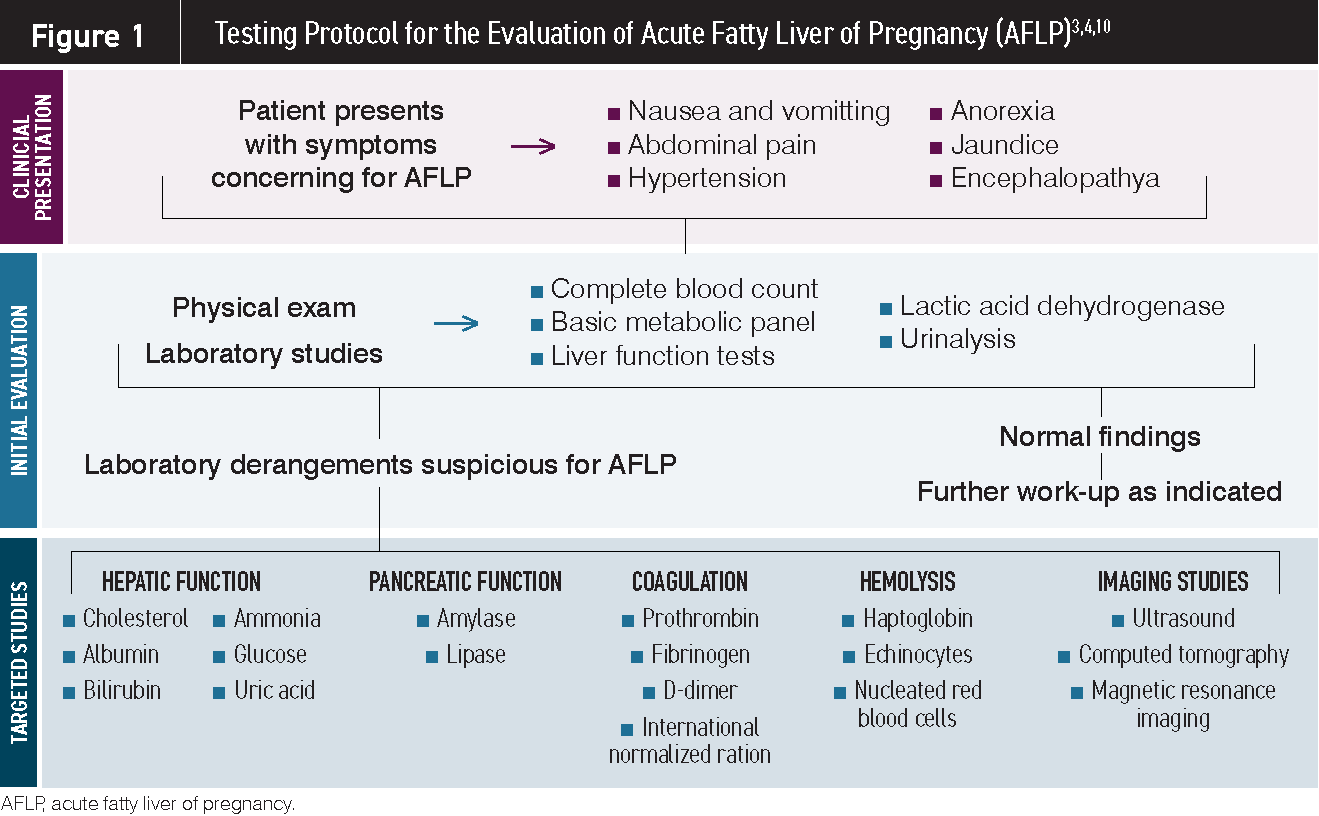
To interpret the battery of laboratory tests used to diagnose AFLP, an understanding of the normal physiologic changes of pregnancy and their associated laboratory alterations is critical. “Normal values,” as referenced by an electronic medical record (EMR), often use reference ranges derived from males and/or nonpregnant women, which may be profoundly abnormal when referenced to the pregnant patient. For example, both serum cholesterol and plasma fibrinogen levels are significantly elevated in the third trimester of a normal pregnancy.15 Therefore, if levels of these analytes in pregnancy fall within the EMR reference range, they may actually be indicative of significant abnormality. Failure to recognize these differences may result in a missed diagnosis or unrecognized complication.
Classically, the Swansea criteria (Table 2) are used to confirm the diagnosis of AFLP.16 To meet the diagnosis of AFLP, 6 of the listed criteria must be met. These criteria are validated and effective; however, utilizing them requires the use of testing modalities that may not be readily available in all facilities.
Table 2. Swansea Criteria for the Diagnosis of Acute Fatty Liver
of Pregnancy16
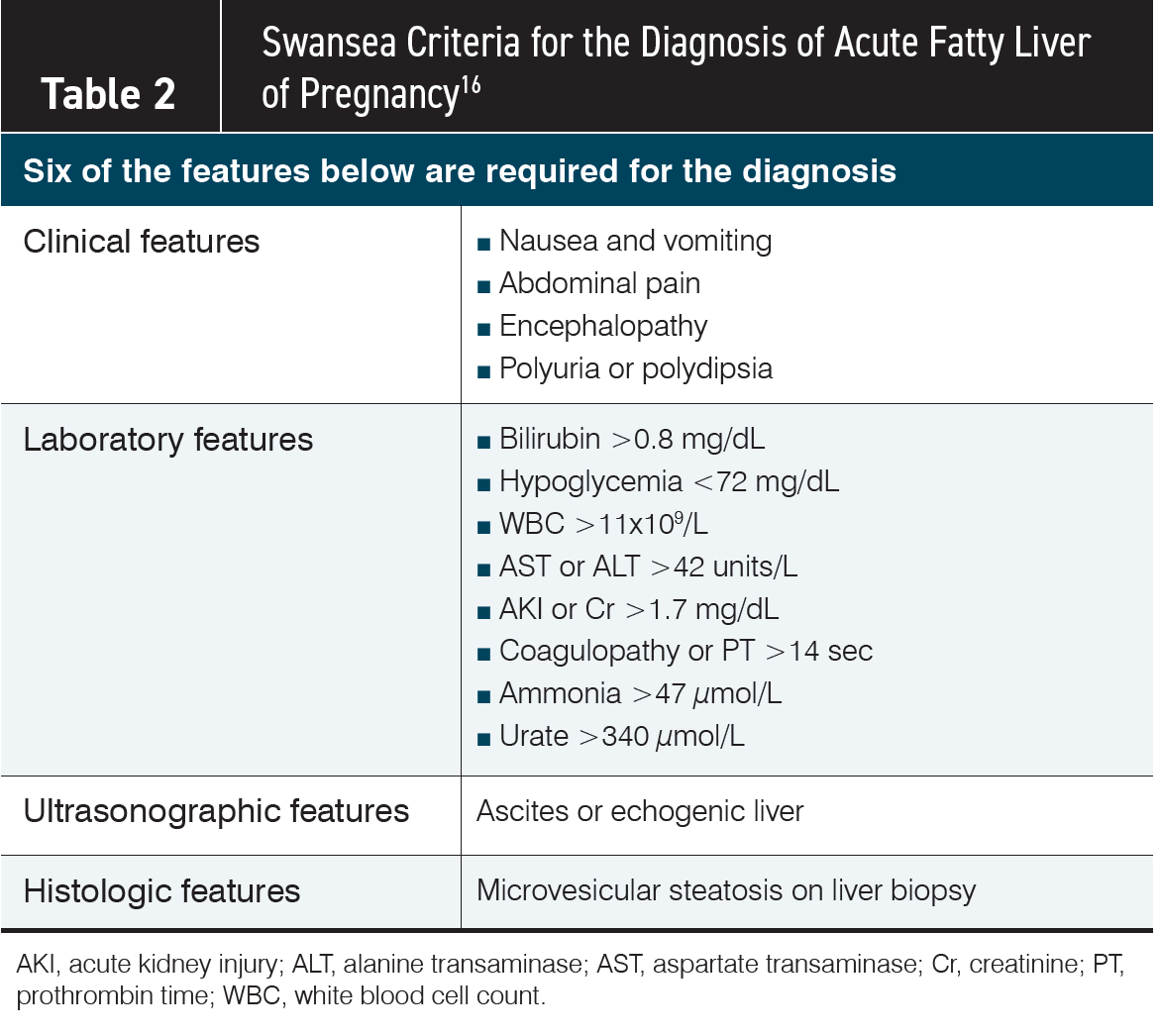
Moreover, some of these analytes require specific laboratory processing. For example, sampling for ammonia—an analyte elevated in hepatic dysfunction—can be influenced by transport of the sample on ice. Although ultrasonographic findings are included in the Swansea criteria, the utility of such findings is limited.1,8,17
Imaging may still prove valuable for exploring the other common obstetric imitators previously mentioned. For example, a right upper quadrant ultrasound may be useful to diagnose a hepatic hematoma in the setting of HELLP syndrome.14,18 The use of liver biopsy was previously performed to diagnose AFLP, but given the challenges of such testing in a coagulopathic patient who has other features indicative of AFLP, it is rarely utilized today.
The laboratory abnormalities associated with AFLP demonstrate multiorgan injury, including hepatic, renal, and hematologic dysfunction. Hepatic dysfunction is characterized by liver damage with transaminase elevation, and by ineffective metabolic function as demonstrated by reduced production of cholesterol and fibrinogen.3,13,15
Renal impairment, caused by both intrinsic and prerenal insults, manifests as elevated serum creatinine—often greater than 1.0 mg/dL.13 Associated hematologic abnormalities are frequently consistent with disseminated intravascular coagulation, characterized by prolonged clotting times, thrombocytopenia, hypofibrinogenemia, and elevated serum fibrin split products (D-dimer).19,20 There is often significant hemolysis, demonstrated by anemia and the presence of nucleated red blood cells.20
These clinical and laboratory features can be useful in differentiating AFLP from HELLP syndrome. For example, patients with AFLP are more likely to present with nausea, vomiting, or jaundice. While hypertension is common to both diagnoses, it is present in only 70% of patients with AFLP and nearly all patients with HELLP syndrome.13,21 Furthermore, AFLP is associated with significantly more hepatic and renal dysfunction as well as coagulopathy, demonstrated through lower fibrinogen levels (<300 mg/dL), lower total cholesterol (<150 mg/dL), higher total bilirubin (>1.0 mg/dL), and more significant renal dysfunction (Creatinine >1.0 mg/dL).13
Management
The clinical management of the patient with AFLP relies on the following principles:
(1) prompt recognition and evaluation of the mother and fetus; (2) planning for supportive care, such as reversal of coagulopathy; (3) preparation for delivery as soon as feasible; and (4) multidisciplinary care with anesthesiologists, intensivists, hepatologists, and pediatricians.3,18,19,22,23
Given the underlying pathophysiology of the disease, it is understood that liver damage will continue until the fetus is delivered. After delivery, maternal recovery may be slow—lasting days to weeks—and often requires considerable supportive care. Any woman who presents with symptoms concerning for AFLP should be admitted to the labor and delivery unit of a hospital that has the ability to escalate care to an intensive care setting.22
Once the patient is admitted, a number of simultaneous measures should be initiated in her care, beginning with close maternal and fetal monitoring. Two large-bore intravenous catheters are placed for maternal resuscitation. For women in whom a diagnosis of preeclampsia is being considered, magnesium sulfate infusion is initiated for eclampsia prophylaxis. In fact, concurrent preeclampsia is seen in approximately 70% of women with AFLP.4,13 Importantly, severe-range hypertension is treated with antihypertensive agents with a goal blood pressure of less than 160/110 mm Hg.18
Consultation with an anesthesiologist is imperative for maternal stabilization and in preparation for delivery. If the patient is encephalopathic or obtunded, airway protection is critical and may require endotracheal intubation. Placement of a nasogastric tube with administration of antacids to neutralize stomach contents may also be considered in patients with persistent nausea and vomiting. Finally, consultation with the pediatric team is recommended for 2 reasons: (1) the need for neonatal resuscitation given the risks of fetal compromise; and (2) neonatal evaluation for metabolic derangements after delivery.3,9
Delivery Considerations
Although delivery is required for the definitive treatment of AFLP, the diagnosis alone is not an indication for cesarean delivery. In fact, vaginal delivery is preferred given the proclivity toward severe coagulopathy in these patients. If vaginal delivery is pursued, vaginal trauma, such as episiotomy, should be avoided. However, the cesarean delivery rate in women with AFLP is ultimately significant, as high as 67%, and is likely driven by fetal indications.10
In the patient undergoing cesarean delivery, management of coagulopathy and preparation for excessive bleeding is critical. If the fetal status permits, coagulopathy should be corrected prior to proceeding with delivery.19 Hypofibrinogenemia should be corrected using fibrinogen-containing products—fresh frozen plasma or cryoprecipitate—with a goal fibrinogen level of at least 150 mg/dL.
Similarly, thrombocytopenia should be corrected with the administration of platelets to a level greater than 50,000/mL. Despite preoperative resuscitation, the risk of intraoperative and postoperative bleeding remains significant. We recommend against the use of a Pfannenstiel incision and prefer a vertical midline skin incision at the time of cesarean delivery. This approach takes advantage of natural avascular surgical planes and allows for exploration of the upper abdomen if necessary. We have identified several cases of hematomas at the level of the rectus muscle in patients who received a Pfannenstiel incision in the setting of concurrent coagulopathy with AFLP. A surgical drain may be placed at the time of abdominal closure if there is ongoing surgical oozing or ascitic fluid within the abdomen; however, this is not our standard practice.
Analgesia and Anesthesia
Decisions regarding anesthesia and analgesia will also be influenced by metabolic and hematologic derangements.23 For women with mild coagulopathy and thrombocytopenia (platelets >70,000/mL), neuraxial anesthesia remains a reasonable option.
Figure 1. Testing Protocol for the Evaluation of Acute Fatty Liver of Pregnancy (AFLP)3,4,10

However, reevaluation of laboratory indices may be necessary prior to removal of an epidural catheter as the nadir of coagulation studies and platelet count may worsen, and not recover, until several days postpartum. In more severe cases, general endotracheal anesthesia may be necessary for maternal airway protection, profound coagulopathy prohibiting regional anesthesia, or in the setting of fetal decompensation necessitating emergent cesarean delivery.
Postpartum Recovery and Complications
While delivery is the definitive treatment of AFLP, postpartum recovery may be prolonged and complicated by ongoing supportive care needs. Close surveillance and supportive care in either an intensive care unit or labor and delivery unit are imperative. Serial measurements of hematologic, hepatic, and renal function should be performed every 6 to 12 hours for the first 1 to 2 days. Anemia is common during this time due to hemolysis or postpartum hemorrhage, and it frequently requires transfusion.
Further, in patients with renal dysfunction who are receiving magnesium sulfate for seizure prophylaxis, serum magnesium levels should be monitored to avoid magnesium toxicity. Blood glucose levels should also be monitored hourly. If levels fall below 60 mg/dL, hypoglycemia should be treated with an infusion of 10% glucose.
Gradual recovery of laboratory analytes should be expected within a week following delivery. Hepatic dysfunction usually begins to improve 1 to 2 days after delivery. Transaminase levels decline linearly to levels of 100 units/L or less, and they may remain mildly elevated for several weeks.
Figure 2. Serial Assessment of AST and Plasma Fibrinogen Following Delivery
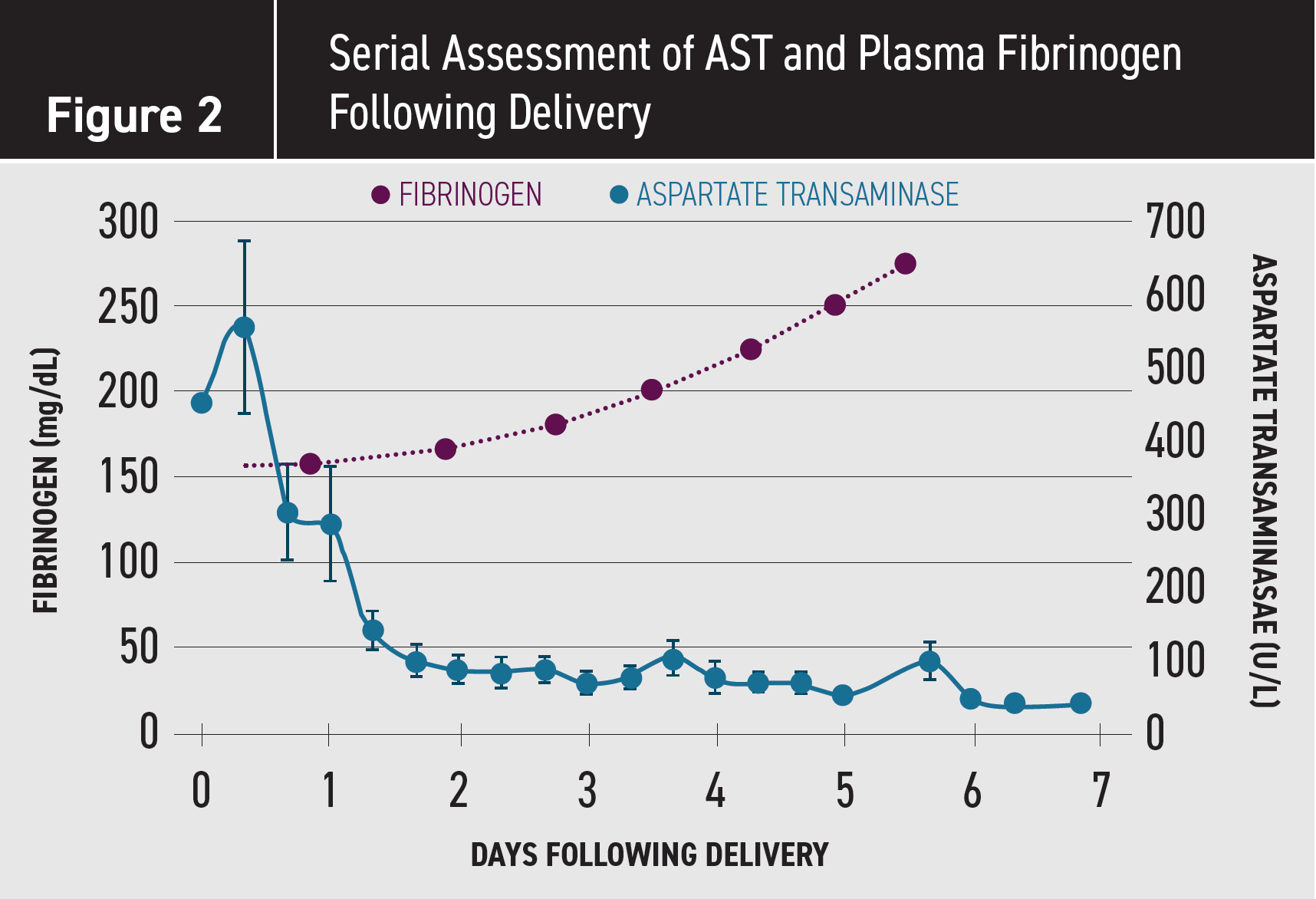
Other markers of hepatic dysfunction, including cholesterol and total bilirubin, begin improving after 3 to 4 days. Hemostatic dysfunction related to either liver synthetic function or consumptive coagulopathy improves over 4 to 6 days postpartum, as indicated by increasing plasma fibrinogen and declining D-dimer. The time course for recovery of aspartate transaminase and serum fibrinogen is shown in Figure 2. By contrast, renal recovery measured by serum creatinine may require 7 to 10 days.3,4,13
The postpartum course may be further complicated in some patients. Up to 15% of women with AFLP will develop pancreatitis.24 This is managed conservatively with intravenous hydration, analgesia, and nasogastric decompression. Transient diabetes insipidus may also be present, and excessive diuresis can be slowed using desmopressin in most cases.4
Rarely, expected hepatic recovery does not occur, and persistent liver failure ensues. This requires management by hepatologists and intensivists and may involve the use of advanced therapies, such as plasma exchange or extracorporeal life-support systems.2,23,25 Transplantation may be necessary in patients with profound persistent hepatic failure with hypotension and acidosis. The need for transplantation is typically later in the recovery course and remote from delivery.2,10
Maternal and Perinatal Outcomes
Together with advances in the diagnosis and management of AFLP, maternal and perinatal outcomes have significantly improved over the past 2 decades. Maternal mortality, which was as high as 80% to 90% in the 1980s, has now decreased to less than 10%.26 Perinatal mortality remains substantial and is now recorded in approximately 20% of AFLP cases.2,4 In a recent review of more than 350 women with AFLP, all survivors had full recovery of hepatic function.4 Despite these improvements, morbidity remains significant. With high rates of associated acute kidney injury, intensive care unit admission, and blood and component transfusion, most cases will trigger a severe maternal morbidity event. The recurrence of AFLP in a subsequent pregnancy is rare,14 but women who are heterozygous for a fatty acid oxidation enzyme defect are at increased risk. Therefore, screening for fatty acid oxidation disorders should be considered in women with a history of AFLP.
Summary
Once AFLP is identified, preparing for delivery and preparing for ongoing supportive maternal care postpartum are paramount. Key elements regarding the care of patients with AFLP are summarized in Table 3. Although AFLP is associated with maternal and infant morbidity and mortality, a multidisciplinary approach may be beneficial.
References
- Castro MA, Fassett MJ, Reynolds TB, Shaw KJ, Goodwin TM. Reversible peripartum liver failure: a new perspective on the diagnosis, treatment, and cause of acute fatty liver of pregnancy, based on 28 consecutive cases. Am J Obstet Gynecol. 1999;181(2):389-395. doi:10.1016/s0002-9378(99)70567-3
- Kushner T, Tholey D, Dodge J, Saberi B, Schiano T, Terrault N. Outcomes of liver transplantation for acute fatty liver disease of pregnancy. Am J Transpl. 2019;19(7):2101-2107. doi:10.1111/ajt.15401
- Nelson DB, Yost NP, Cunningham FG. Acute fatty liver of pregnancy: clinical outcomes and expected duration of recovery. Am J Obstet Gynecol. 2013;209(5):456.e1-e7. doi:10.1016/j.ajog.2013.07.006
- Nelson DB, Byrne JJ, Cunningham FG. Acute fatty liver of pregnancy. Obstet Gynecol. 2021;137(3):535-546. doi:10.1097/AOG.0000000000004289
- Casey LC, Fontana RJ, Aday A, et al; Acute Liver Failure Study Group. Acute liver failure (ALF) in pregnancy: how much is pregnancy related? Hepatology. 2020;72(4)1366-1377; doi:10.1002/hep.31144
- Reye RD, Morgan G, Baral J. Encephalopathy and fatty degeneration of the viscera. a disease entity in childhood. Lancet. 1963;2(7311):749-752. doi:10.1016/s0140-6736(63)90554-3
- Strauss AW, Bennett MJ, Rinaldo P, et al. Inherited long-chain 3-hydroxyacyl-CoA dehydrogenase deficiency and a fetal-maternal interaction cause maternal liver disease and other pregnancy complications. Semin Perinatol. 1999;23(2):100-112. doi:10.1016/s0146-0005(99)80044-5
- Browning MF, Levy HL, Wilkins-Haug LE, Larson C, Shih VE. Fetal fatty acid oxidation defects and maternal liver disease in pregnancy. Obstet Gynecol. 2006;107(1):115-120. doi:10.1097/01.AOG.0000191297.47183.bd
- Ibdah JA, Bennett MJ, Rinaldo P, et al. A fetal fatty-acid oxidation disorder as a cause of liver disease in pregnant women. N Engl J Med. 1999;340(22):1723-1731. doi:10.1056/NEJM199906033402204
- Nelson DB, Byrne JJ, Cunningham FG. Acute fatty liver of pregnancy. Clin Obstet Gynecol. 2020;63(1):152-164. doi:10.1097/GRF.0000000000000494
- Monga M, Katz AR. Acute fatty liver in the second trimester. Obstet Gynecol. 1999;93(5 Pt 2):811-813.doi:10.1016/s0029-7844(98)00519-5
- Bacq Y. Liver disease unique to pregnancy: a 2010 update. Clin Res Hepatol Gastroenterol. 2011;35(3):182-193.doi:10.1016/j.clinre.2010.11.011
- Byrne JJ, Seasely A, Nelson DB, Mcintire DD, Cunningham FG. Comparing acute fatty liver of pregnancy from hemolysis, elevated liver enzymes, and low platelets syndrome. J Matern Fetal Neonatal Med. Published online April 19, 2020.doi:10.1080/14767058.2020.1754790
- Sibai BM. Imitators of severe preeclampsia. Obstet Gynecol. 2007;109(4):956-966.doi:10.1097/01.AOG.0000258281.22296.de
- Abbassi-Ghanaviti M, Greer LG, Cunningham FG. Pregnancy and laboratory studies: a reference table for clinicians. Obstet Gynecol. 2009;114(6):1326-1331.doi:10.1097/AOG.0b013e3181c2bde8
- Ch’ng CL, Morgan M, Hainsworth I, Kingham JGC. Prospective study of liver dysfunction in pregnancy in Southwest Wales. Gut. 2002;51(6):876-880. doi:10.1136/gut.51.6.876
- Nelson DB, Khan A, Bailey A, et al. Liver injury in hemolysis, elevated liver enzymes, and low platelets syndrome measured by diffusion-weighted magnetic resonance imaging. Am J Perinatol. 2018;35(8):741-747. doi:10.1055/s-0037-1613684
- Hypertension in pregnancy. Report of the American College of Obstetricians and Gynecologists’ Task Force on Hypertension in Pregnancy. Obstet Gynecol. 2013;122(5):1122-1131. doi:10.1097/01.AOG.0000437382.03963.88
- Cunningham FG, Nelson DB. Disseminated intravascular coagulation syndromes in obstetrics. Obstet Gynecol. 2015;126(5):999-1011.doi:10.1097/AOG.0000000000001110
- Nelson DB, Yost NP, Cunningham FG. Hemostatic dysfunction with acute fatty liver of pregnancy. Obstet Gynecol. 2014;124(1):40-46. doi:10.1097/AOG.0000000000000296
- Vigil-De Gracia P. Acute fatty liver and HELLP syndrome: two distinct pregnancy disorders. Int J Gynecol Obstet. 2001;73(3):215-220. doi:10.1016/s0020-7292(01)00364-2
- ACOG [American College of Obstetricians and Gynecologists] practice bulletin no. 211: critical care in pregnancy. Obstet Gynecol. 2019;133(5):e303-e319. doi:10.1097/AOG.0000000000003241
- Naoum EE, Leffert LR, Chitilian HV, Gray KJ, Bateman BT. Acute fatty liver of pregnancy: pathophysiology, anesthetic implications, and obstetrical management. Anesthesiology. 2019;130(3):446-461.doi:10.1097/ALN.0000000000002597
- Moldenhauer JS, O’Brien JM, Barton JR, Sibai B. Acute fatty liver of pregnancy associated with pancreatitis: a life-threatening complication. Am J Obstet Gynecol. 2004;190(2):502-505. doi:10.1016/j.ajog.2003.09.022
- Yu C-B, Chen J-J, Du W-B. Effects of plasma exchange combined with continuous renal replacement therapy on acute fatty liver of pregnancy. Hepatobiliary Pancreat Dis Int. 2014;13(2):179-183. doi:10.1016/s1499-3872(14)60028-x
- Varner M, Rinderknecht NK. Acute fatty metamorphosis of pregnancy. a maternal mortality and literature review. J Reprod Med. 1980;24(4):177-180.
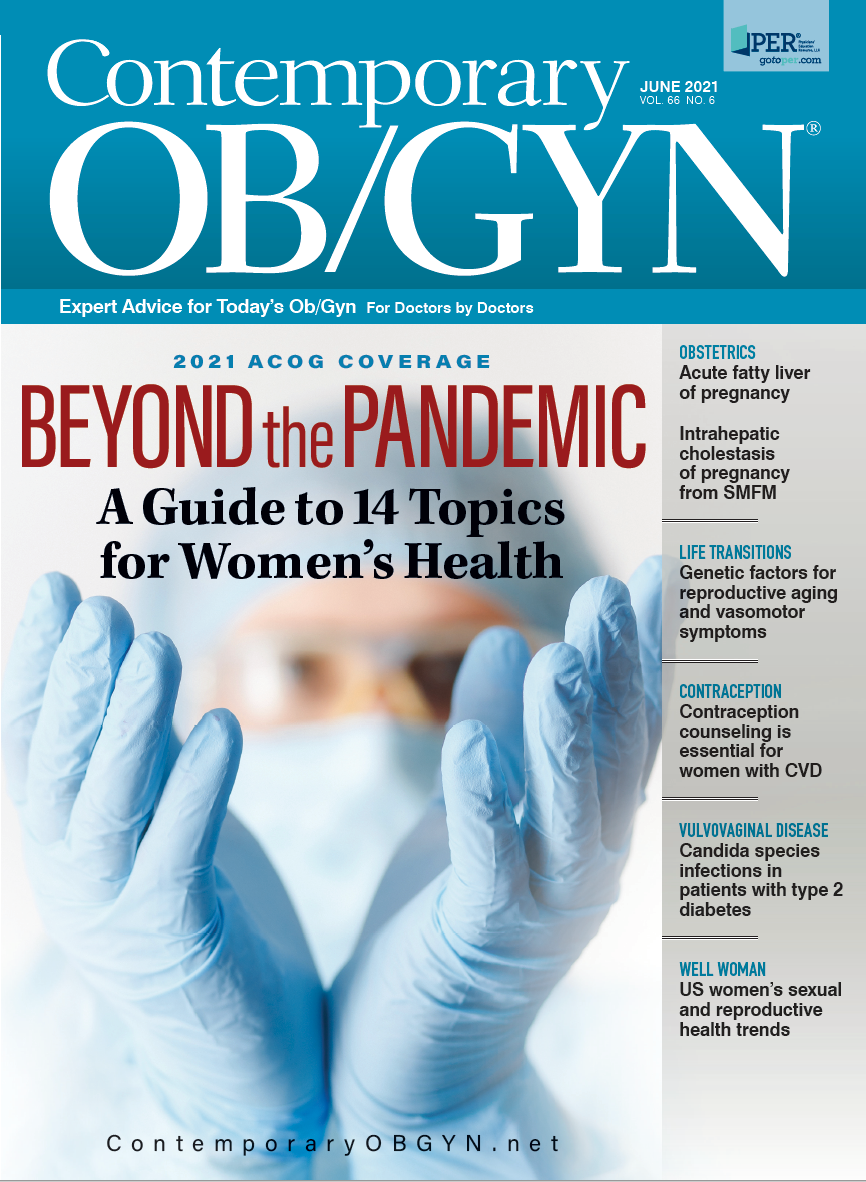
S4E1: New RNA platform can predict pregnancy complications
February 11th 2022In this episode of Pap Talk, Contemporary OB/GYN® sat down with Maneesh Jain, CEO of Mirvie, and Michal Elovitz, MD, chief medical advisor at Mirvie, a new RNA platform that is able to predict pregnancy complications by revealing the biology of each pregnancy. They discussed recently published data regarding the platform's ability to predict preeclampsia and preterm birth.
Listen
Racial disparities based on delivery hospital quality reported
March 24th 2025A new study found that Black and American Indian birthing individuals in the United States are more likely to deliver at lower-quality hospitals than White patients, highlighting systemic health care inequities.
Read More
sFLT1/PLGF ratio may improve risk stratification for birth outcomes
March 17th 2025A recent study suggests that the soluble fms-like tyrosine kinase 1 to placental growth factor ratio can help predict clinical deterioration, intrapartum fetal distress, and mode of delivery, offering valuable insights for patient counseling and labor management.
Read More
